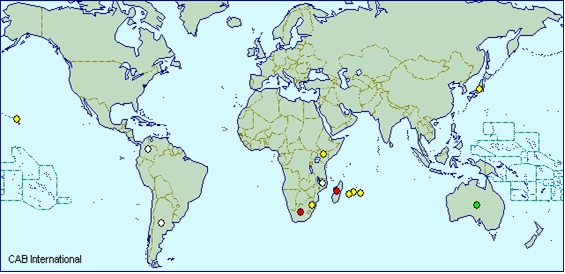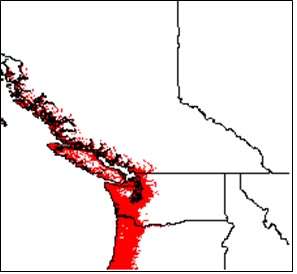RMD-13-04: Consolidated Pest Risk Management Document for pest plants regulated by Canada
Appendix 13A: Pest Risk Assessment Summary for Senecio madagascariensis (Madacascar ragwort)
This page is part of the Guidance Document Repository (GDR).
Looking for related documents?
Search for related documents in the Guidance Document Repository
- Identity of Organism
- Organism Status
- Current Regulatory Status
- Probability of Entry
- Probability of Establishment
- Probability of Spread
- Potential Economic Consequences
- Potential Environmental and Social Consequences
- Uncertainty
- Conclusion
- Technical Issues for Consideration
Identity of Organism
Name: Senecio madagascariensis (Asteraceae) (USDA-ARS 2009)
Synonyms: Senecio incognitus Cabrera (USDA-ARS 2009)
English common names: Fireweed, Madagascar ragwort (USDA-ARS 2009), variable groundsel (Starr et al. 1999)
French common names: Séneçon de Madagascar
Taxonomic note: As noted in PRA 2009-20 sein (Senecio inaequidens DC.), the distinction between Senecio inaequidens (2n=40) and Senecio madagascariensis (2n=20) is controversial (International 2007; Lafuma et al. 2003; López et al. 2008). For the purposes of this risk assessment they are considered to be distinct taxa in accordance with the USDA Germplasm Resources Information Network (USDA-ARS 2009). Detailed investigation of populations from the exotic ranges of these species, together with several other closely related Senecio species from southern Africa is needed to understand the genetics, systematics and morphological variation of Senecio madagascariensis (CAB International 2007).
Description: It is a broadleaved, herbaceous, short-lived, branched perennial with golden yellow flowers (CAB International 2007; Starr et al. 1999). The plant has erect stems that reach 60 cm (CAB International 2007). Its leaves are bright green, alternate, occasionally petiolate and variable, reaching 12 cm long and 2.5 cm wide (CAB International 2007). Plants produce 2 to 200 small daisy-like flowers per plant, which appear at the branch tips (Starr et al. 1999). Seeds are achenes measuring approximately one to three mm long (Starr et al. 1999). Each has a white pappus, with hairs two to three times as long as the achenes (CAB International 2007; Starr et al. 1999).
Organism Status
It is not reported to occur in Canada, and no evidence was found that it has been cultivated in Canada (CAB International 2007; CFIA 2008; CNLA 2008; Isaacson and Allen 2007; Scoggan 1979). Based on this information Senecio madagascariensis is considered to be absent in Canada.
Current Regulatory Status
It is not currently regulated in Canada. It is regulated as a Federal Noxious Weed in the United States (USDA-APHIS 2006) and at the state level in Hawaii (HEAR 2003). It is also listed as a noxious weed in Australia, in New South Wales, Western Australia, Queensland and the Australian Capital Territory (Australian Weeds Committee 2008) and in Japan (Government of Japan 2006).
Probability of Entry
Potential pathways for introduction of Senecio madagascariensis into the PRA area are primarily unintentional pathways (Table 1). There is a moderate risk of this species entering the PRA area on travelers, on their clothing, shoes, or personal effects. Additional, minor pathways include imports of grass or pasture seed for planting and imports of livestock from areas where this plant is present. From the year 2000 to present, Senecio madagascariensis has not been detected in samples analysed by the CFIA Seed Lab.
| Type of pathway | Specific Pathways |
|---|---|
| Natural dispersal | Wind is considered to be the major factor for dispersal of seeds over large areas and long distances (i.e. seeds are light and spread easy by wind) The risk of natural dispersal into Canada is low because there are no populations near Canadian borders. |
| Intentional Introduction | None identified |
| Unintentional Introduction |
Contaminated shoes, clothing and personal effects of travellers may be the most likely of these pathways due to the high frequency of human travel between Canada and Hawaii, Australia, Japan, Colombia, Argentina and southern Africa. The remaining pathways are low risk. |
Probability of Establishment
Senecio madagascariensis is native to South Africa (Cape Province, Natal, Transvaal), Swaziland (USDA, ARS, 2009), Mozambique and Madagascar (CAB International 2007) (Figure 1). It is introduced in Kenya, Mauritius, U.S. (Hawaii), Argentina (Buenos Aires, Santa Fe, Entre Rios, Corrientes and Mendoza), Colombia, Australia (New South Wales, Queensland, and Victoria) (CAB International 2007) and Japan (Koike et al. 2006).
Note: a red dot indicates widespread; yellow indicates present but no further details; white indicates present and localized; green indicates present with additional regional information available (CAB International 2007).

Description of Figure 1:
This image is a distribution map of Senecio madagascariensis (Madagascar ragwort) in the world. You can see a map of the world which contains red dots signifying Senecio madagascariensis is widespread, yellow dots indicating that it is present but with no further details, white dots denoting a presence that is localized and green dots signifying that it is present with additional regional information available. South America has two whites dots located in Columbia and Argentina. At the centre of Australia there is a green dot. Asia has a yellow dot in the vicinity of Japan while another yellow dot can be seen in the Hawaiian Islands of North America. Lastly and most pervasively, there are yellow, white and red dots scattered along the lower half of the continent of Africa more specifically in Kenya which has a yellow dot as well as Swaziland and Mauritius which has multiple; Madagascar has a red dot and Mozambique has white one.
Source: CAB International 2007.
In general, this species is opportunistic and able to colonize a wide range of habitats, "from low-elevation arid pastures and coastal plains to higher-elevation, moist pastures, yards, fields and roadsides" (Starr et al. 1999). It often occurs in overgrazed or neglected pastures as well as cultivated or disturbed land (Starr et al. 1999). Although it has been found in both shady and sunny sites, it does not perform well in pastures over 1 m tall (CAB International 2007). Both high and low fertility soils, as well as a range of soil textures, are suitable for its growth. It is tolerant of drought (Plant and Robertson 2007) but does not survive in poorly drained or waterlogged soils (Starr et al. 1999; Watson et al. 1997). Senecio madagascariensis appears to be most successful in humid maritime sub-tropical climates and tends to be restricted to climates with low frost incidence (CAB International 2007; Sindel and Michael 1992). Frost may kill seedlings and reduce plant vigor (Sindel and Michael 1992; Starr et al. 1999).
Based on its current distribution and the results of the North Carolina State APHIS Plant Pest Forecasting (NAPPFAST) System it may adapt to plant hardiness zones 8 and higher. In Canada, zones 8 and above are restricted to coastal British Columbia and Vancouver Island (Figure 2). Within the area at risk, the dominant biogeoclimatic zone is coastal western hemlock, and there are small areas of coastal Douglas-fir as well (BC Ministry of Forests 1999). While unlikely to establish in mature forests, Senecio madagascariensis may be capable of establishing in the warm, humid disturbed areas of these biogeoclimatic zones.

Description of Figure 2:
This image shows the potential distribution of Senecio madagascariensis (Madagascar ragwort) in Canada, more specifically in British Columbia. Red is used to indicate the regions in which Senecio inaequidens could survive according to the Canadian Plant Hardiness Zones map, in this case NAPPFAST Hardiness Zones 8. In Canada, the potential range of Senecio madagascariensis is very limited to include only coastal British Columbia where it has a scattered presence. This image is narrowed to include parts of the U.S. more specifically Washington and Oregon where the red has more of a prevalent presence and is heavily condensed.
Probability of Spread
It is a highly adaptable species with an ability to grow vigorously and spread rapidly after introduction. Seeds are small and light (Plant and Robertson 2007). Seed production, which is extended over a period of weeks, is prolific (100 to 150 seeds per flower, 25,000 to 30,000 per plant) and germination rates are high (Starr et al. 1999). Light infestations can result in 1,000,000 seeds per hectare (Queensland Government 2007). Seeds are capable of germinating immediately after release, and quickly cover areas recently disturbed by fire or cultivation before more desirable species have a chance to emerge (Plant and Robertson 2007). Once present in an area, the species is easily dispersed by wind and other natural and unintentional human-mediated means (see Probably of Entry). Within Australia, contaminated fodder has been identified as one means of spread of Senecio madagascariensis (Bega Valley Fireweed Association no date).
Potential Economic Consequences
It is a serious pest plant in Australia and Hawaii (Starr et al. 1999). Its introduction to Japan has been fairly recent, but it is spreading rapidly there as well (Koike et al. 2006). In Colombia and Argentina, its distribution is currently considered localized (CAB International 2007). The main economic impact of this species is reduced pasture productivity (CAB International 2007). It is a strong competitor with desired pasture species and also has toxic effects on livestock (CAB International 2007). Consumption of large quantities of Senecio madagascariensis has resulted in acute poisoning and death of livestock due to pyrrolizidine alkaloid toxicosis. Consumption of smaller quantities over longer periods results in sublethal liver poisoning. Poultry, pigs, cattle and horses are all sensitive to pyrrolizidine alkaloids. Sheep and goats are fairly resistant, but continuous exposure should be avoided (CAB International 2007). In Australia, over a decade ago, costs due to herbicide use and toxic effects on cattle were estimated to be $11 million (currency not stated) in non-drought years (DRDC 1996, cited in Starr et al. 1999).
The establishment of Senecio madagascariensis into Canada would threaten Canada's ability to export commodities to the United States where it is a designated Federal Noxious Weed, as well as Australia and Japan.
Potential Environmental and Social Consequences
It can have a negative effect on biodiversity by competing with native vegetation such as grass and other low-growing plants (CAB International 2007; Sindel et al. 1998). Changes to the vegetative composition of an area due to this species may also promote soil erosion (CAB International 2007).
Uncertainty
No significant areas of uncertainty identified.
Conclusion
Senecio madagascariensis could become invasive in parts of Canada (coastal British Columbia and Vancouver Island) if it were introduced.
Technical Issues for Consideration
Senecio taxa may be distinguished based on shorter achenes (1.5 mm to 2.0 mm) and hairs confined to the achene grooves in Senecio madagascariensis as compared to longer achenes (2.5 mm) and completely hairy achenes in Senecio inaequidens. These differences should be treated with caution as they are based on limited sampling (CAB International 2007; Radford et al. 2000).
- Date modified: